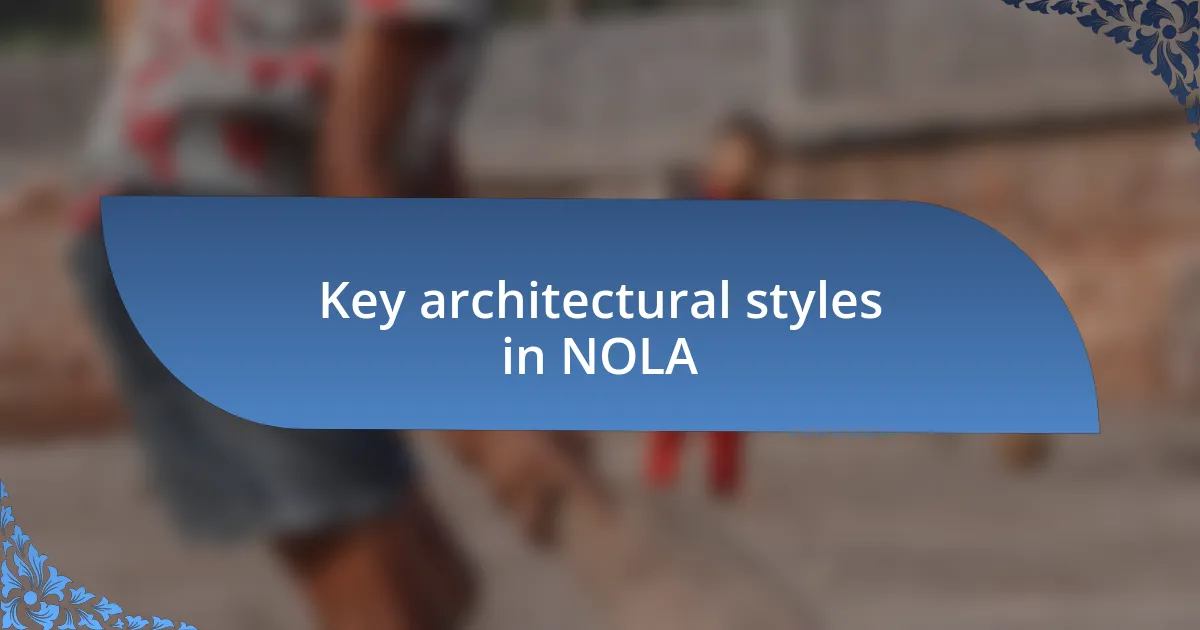Key takeaways:
- NOLA’s architecture showcases a rich blend of French, Spanish, and Creole influences, reflecting the city’s vibrant history and community resilience.
- Key architectural styles include Greek Revival, Italianate, Creole Cottage, and Victorian, each contributing uniquely to the city’s character.
- Preservation efforts, notably by organizations like the Vieux Carré Commission, play a crucial role in maintaining NOLA’s historic integrity and cultural heritage.
- Personal experiences highlight the emotional and cultural connections people form with NOLA’s architectural landscape, showcasing the profound stories these structures carry.

Introduction to NOLA’s architecture
When I think about New Orleans’ architecture, it feels like stepping into a vibrant storybook. Each building seems to whisper tales of its past, reflecting a unique blend of French, Spanish, and Creole influences. How often do we stroll past a façade and wonder about the lives woven into its history?
Walking through the streets of the French Quarter, I can’t help but feel captivated by the intricate ironwork and colorful façades that beckon you to explore further. I remember my first encounter with a historic shotgun house — its long, narrow design fascinated me. It’s remarkable how a structure can evoke such a deep connection to both place and time.
The rich textures and diverse styles found in NOLA’s architecture aren’t just visually appealing; they evoke a profound sense of community and resilience. I often find myself pondering: What stories do these walls hold amidst the celebrations and storms? Each corner of the city seems to present a new perspective, inviting us to appreciate the beauty of a place shaped by the hands of many.

Historical significance of NOLA architecture
The architectural landscape of New Orleans is like a living museum, showcasing centuries of history shaped by cultural convergence. I particularly cherish the iconic St. Louis Cathedral, which stands proudly in Jackson Square, reflecting the city’s Spanish colonial past. On my visits, I find myself reflecting on how this structure has witnessed monumental events, from the rise of jazz to the struggles of the people, giving one a tangible connection to history.
Interestingly, the shotgun houses, a signature element of NOLA’s architectural identity, reveal much about the city’s social history. I recall wandering through neighborhoods and spotting these narrow houses, arranged in rows. It’s fascinating how they were designed for efficiency and community living, speaking to the resilience of families who endured periods of strife, yet remained tightly knit. These designs tell us a story of adaptation, innovation, and survival in the face of adversity.
Lastly, the preservation efforts in New Orleans make its architecture even more significant. As I’ve explored the historic districts, each renovation and restoration job I encountered reminded me of the city’s commitment to honoring its past. This dedication tells me that the buildings are not just structures; they represent a collective memory worth preserving for generations. It raises a compelling question: How many cities can genuinely boast such an enduring connection to their past?
| Architectural Element | Historical Significance |
|---|---|
| St. Louis Cathedral | Symbol of Spanish colonial influence; venue for important historical events |
| Shotgun Houses | Reflects social history and community living; emblematic of resilience |
| Preserved Buildings | Demonstrates cultural heritage; commitment to maintaining historical integrity |

Key architectural styles in NOLA
Key architectural styles in NOLA reveal a rich tapestry of influences, each contributing to the city’s unique character. While wandering through the French Quarter, I remember the enchanting wrought-iron balconies that grace many of the buildings. They invite you to imagine the gatherings that once took place there, the stories whispered over countless cups of coffee, infusing the space with a sense of nostalgia and intimacy.
Key styles include:
- Greek Revival: Often characterized by large columns and pediments, reflecting the ideals of democracy.
- Italianate: Features elaborate window treatments and bracketed eaves, evoking a romantic feel.
- Creole Cottage: This style marries function with simplicity, often adorned with broad porches.
- Victorian: Adds a splash of color and ornate detail, showcasing opulence and creativity.
Every stroll through these neighborhoods feels like a step back in time, as if I’m walking alongside the city’s vibrant past. The layers of architecture tell stories of immigration, adaptation, and the spirited resilience of the NOLA community. I cherish how each structure contributes to the city’s narrative, pulling me deeper into its architectural embrace.

Elements of NOLA’s architectural charm
The charm of NOLA’s architecture often lies in its intricate details, like the colorful tiles often seen in the posts and steps of many homes. I can still recall the moment I discovered a hidden courtyard, where those tiles shimmered under the sunlight, telling me a story of craftsmanship and culture. It made me wonder: how many generations have tread those paths?
One striking element that captivates me is the use of shutters, which are not just functional but a visual delight. I remember sitting on a balcony, the shutters swinging gently in the breeze, and feeling a sense of connection to the history that enveloped me. Don’t you think these little details add to the city’s soul, providing a window into the lives of its residents?
Walking through NOLA, you can’t help but notice the contrasts in height and design of the buildings. Some structures rise tall and proud, while others are low and inviting. I often find myself lost in thought, pondering how these differences reflect the city’s eclectic spirit. Isn’t it fascinating how architecture can express the vibrancy of a community?

Preservation efforts in NOLA
NOLA’s preservation efforts are deeply intertwined with its essence; many organizations dedicate themselves to safeguarding the architectural heritage of the city. I remember attending a community meeting where passionate locals shared their concerns about new developments threatening historic neighborhoods, igniting a fire within me. Isn’t it remarkable how those voices can band together to protect what makes this city unique?
There’s something particularly inspiring about the work carried out by the Vieux Carré Commission, which ensures that changes in the French Quarter are respectful of its historic character. I often reflect on how this commitment to preserving the past shapes the everyday experiences of both locals and tourists alike. Seeing a beautiful balcony restored to its former glory evokes a sense of pride—don’t you feel that connection to the past when you see such dedication?
Moreover, the annual events celebrating preservation are truly magical. During these gatherings, I’ve listened to stories from artisans and craftsmen who breathe life back into deteriorating buildings. Their enthusiasm is contagious, reminding me that protecting NOLA’s architectural beauty is not merely a task, but a heartfelt effort to honor the stories and lives woven into the very fabric of this city. It begs the question: how much of our own history are we willing to fight for?

Personal experiences with NOLA architecture
Walking through the streets of New Orleans, each building seems to tell a story. I vividly recall the first time I stood in front of a stunning Creole townhouse, its colorful façade reflecting years of history and culture. The charm of its intricate ironwork left me in awe; it felt like stepping into a piece of art. Doesn’t it strike you how architecture can transport you through time?
One morning, I found myself at the historic Lafayette Cemetery No. 1, surrounded by the iconic above-ground tombs that are so emblematic of NOLA. As I read the inscriptions and admired the unique designs, I couldn’t help but feel a profound connection to the generations buried there. How remarkable is it that these structures not only honor the deceased but also serve as a testament to the city’s rich architectural dialogue?
I’ve also had the pleasure of wandering through the Garden District, where each house exudes its own personality. A friend and I often joked about which mansion we’d choose to live in if we had the chance. But beyond the playful banter, these homes represent the dreams and aspirations of a bygone era. Doesn’t it make you wonder how many stories have unfolded within those walls?


